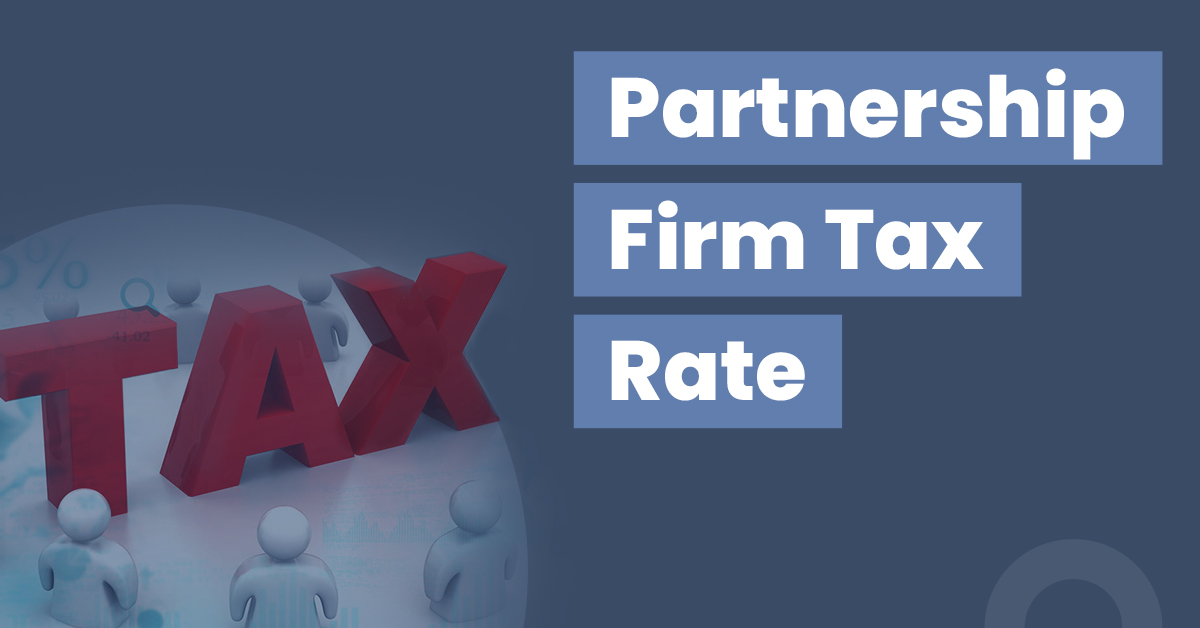A Guide for Partnership Firm Tax Rate


Income tax is imposed by the government on income made by individuals, corporations, and partnership firms. Taxpayers are required by law to file an income tax return each year in order to fulfil their tax obligations. It is critical to understand how tax applies to individuals and businesses to better comprehend your tax liability. Depending on the structure of the business, the tax implications differ. For instance, partnership firms are treated the same as the LLPs and attract a partnership firm tax rate.
Continue reading to learn more about partnerships, and partnership firm tax rates which will help you understand the tax planning for partnership firms.
What is a Partnership Firm?
The Indian Partnership Act, of 1932 governs partnership firms in India. Section 4 of the Act outlines that –
A partnership is a relationship formed by two or more people who have agreed to split the profits of a business. This business is carried on by all or any of them acting for all. Each of these people is referred to as a partner. Profits and losses are shared by all the partners in proportion to their respective ownership, or as agreed between them. Decisions made by a partnership firm are made collectively.
Essential conditions to be a partnership firm
Following the definition given above, a partnership consists of five elements:
- Contract for Partnership
A contract creates a partnership. It is not the result of birth, status, or the operation of the law.
- A partnership can have a maximum of 50 partners.
According to Rule 10 of the Companies (Miscellaneous) Rules,2014, a firm can have up to 50 partners. As a result, a partnership cannot have more than 50 members.
- Business Operations in a Partnership
The third essential component of a partnership is that the parties have agreed to conduct business together. If the goal is to do some charitable work, it will not be a partnership.
- Profit Distribution
This essential component states that the agreement to conduct business must have the goal of sharing profits among all partners. If a business is run for philanthropic purposes rather than profit, or if only one of the partners is entitled to the entire business’s profits, then it is not a partnership.
- Mutual Agency in a Partnership
The fifth component of the definition of partnership requires that the business must be carried on by all of the partners or by any (one or more) of them acting on their behalf, i.e. there must be mutual agency. As a result, each partner acts as both an agent and a principal for himself and other partners, i.e. he can bind and be bound by the actions of other partners.
Types of partners
- Active/Managing Partner – An active partner actively participates in the operation and management of the business. He handles day-to-day business operations on behalf of other partners.
- Sleeping Partner – A sleeping partner, frequently referred to as a dormant partner, is someone who has enough money or an interest in the company but cannot devote sufficient time.
- Nominal Partner – A notional partner has no real or significant stake in the partnership firm. He is merely lending his name to the firm and does not have a significant say in its management.
- Partner in Profits only – These partners will solely share the firm’s profits and will not be liable for the firm’s losses.
- Minor Partner – A minor is a person who has not reached the age of majority under the law. A minor will share the firm’s gains if all other partners agree for the same, but his liability for losses is limited to his part of the firm.
- Outgoing partner – A departing or outgoing partner retires freely without dissolving the firm.
- Limited partner – A limited partner’s liability is limited to the amount of capital he contributes to the partnership firm.
- Sub-Partner – A Sub-partner is a partner in a partnership firm who agrees to split his profits with an outsider to the firm. Sub-partners are not responsible for the firm’s obligations and have no rights against it.
Partnership Firm Tax for AY 2023-24
A partnership firm (including an LLP) is taxable at 30% for the Assessment Year 2023-24 plus any additional tax applied ( surcharge, health, and education cess, and alternative minimum tax), wherever applicable under the provision of the Income Tax Act.
Surcharge
A surcharge is a tax on top of tax. It is levied on the tax owed rather than the money earned. Surcharge is levied on the amount of income tax at different rates if Total Income exceeds specified limits. When total income surpasses one crore rupees, the amount of income tax is increased by a surcharge of 12% of such tax.
Health & Education Cess
A cess is a type of tax collected by the government to aid in the development or welfare of a specific service or industry. It is in addition to direct and indirect taxes. Health & Education cess of 4% shall also be paid on the amount of income tax plus Surcharge (if any).
Alternate Minimum Tax
The Alternative Minimum Tax (AMT) is a leviable alternative to regular taxation. Where the regular tax liability is less than 18.5% of book profit, a firm or LLP must pay an Alternative Minimum Tax of 18.5% of book profit (plus Surcharge and Health and Education cess, where applicable).
Tax on the Income of Partnership Firms
- Partnership firms and LLPs are subject to income tax at a flat rate of 30%. Tax on the income of partnership firms is not computed based on Income Tax Slab Rates because slab rates are only available to individuals and HUFs.
- Health and education cess and AMT are required to be paid. Additionally, in the case of a partnership firm when total income exceeds Rs 1 crore in a financial year, a 12% surcharge would also be applicable.
- Section 112 – Capital gains on the sale of any asset by the partnership business are taxable.
- Section 111A – In the case of the sale of shares, or mutual funds, if the holding term is less than 1 year, the income acquired is taxable at 15%.
- Section 40(b) – Authorises tax deduction of remuneration and interests awarded to partners in a partnership firm under the heading PGBP (profit and gain from business or profession), subject to the limits and circumstances established in this section. Wages and interest exempted under Section 40(b) or any other section shall not be added to the partners’ income.
- The firm’s total income is exempt from the individual partner’s hands because it has already been taxed on the partnership firm.
- The firm’s losses should be carried forward and not assigned to the partners.
- If the partnership firm is incapable of paying the tax obligations, the partners may be found liable for the tax debt recovery.
Final Words:
The term “partnership” is defined in Section 4 of the Indian Partnership Act of 1932. A partnership firm is taxed separately. There is no difference in calculation between registered and unregistered businesses. A partnership firm should submit its partnership deed during the first year of its assessment and only when the conditions and constitution of the partnership alter. The terms partnership, partner, and firm, as defined in section 2 (23) of the Income Tax Act, have the same meaning as in the Indian Partnership Act, 1932.
FAQs
Is a partnership required to pay income tax?
Yes, a partnership firm is taxable at 30% for the fiscal year 2023-24.
What exactly is a surcharge?
If Total Income exceeds above a certain limit, a surcharge is paid at various rates on the amount of income tax. If your taxable income exceeds one crore, you will be taxed at a rate of 12%.
Is it necessary to submit an ITR for a partner in a partnership firm?
If a partner in the firm has no income from the firm in the form of interest, salary, etc., and only exempt income in the form of a share of the firm’s profit, he must utilise form ITR-3 rather than Form ITR-2.
Which ITR form is applicable to a partnership firm?
The Form ITR-5 must be used when filing tax returns for a partnership firm. The form ITR-5 is used to file tax returns for the partnership firm rather than the partners.




